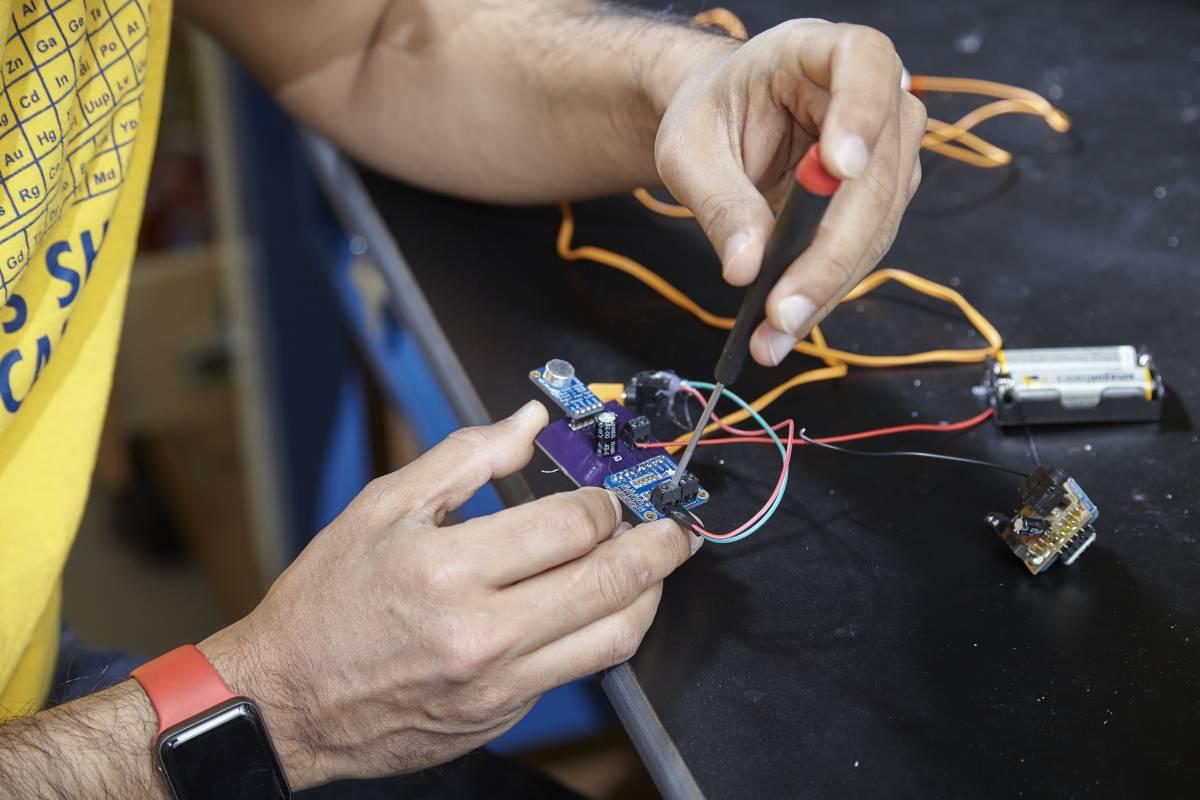A Georgia Tech engineer creates medical equipment for pennies on the dollar

Saad Bhamla was chatting with an undergrad one day, when he noticed his student was tilting his head at a particularly odd angle. Apparently, one of the batteries had stopped working in his hearing aid mid conversation. Bhamla began asking about the hearing aids, learning that his student had a been using the $5,000 device for nearly 18 years.
Bhamla wondered why the hearing device cost so much. Regardless of age or condition, hearing aids aren’t covered by insurance. And yet, they are necessary to retain a good quality of life. So, with that, Bhamla decided he would create an affordable hearing aid that anyone can use.
“I asked myself, ‘Why are reading glasses affordable but hearing aids are not?’” said Bhamla, assistant professor at Georgia Tech’s School of Chemical and Biomolecular Engineering. “Can we make hearing aids as affordable as glasses so that anyone can have access to them?”
To date, Bhamla and his team are working on creating an ambitious ultra low-cost hearing aid, that would potentially cost less than a dollar. Although this work is in early stages, it could have potential payoff for millions of people who could benefit from accessible and affordable hearing aids. Bhamla’s lab also has the potential to have far-reaching effects, with grants from the NSF, Mindlin Foundation, Capita Foundation and National Geographic Foundation.
“I asked myself, ‘Why are reading glasses affordable but hearing aids are not? Can we make hearing aids as affordable as glasses so that anyone can have access to them?”
A device like Bhamla’s hearing aid is built on the principles of frugal science. According to Bhamla, access today to scientific tools and healthcare devices still has many barriers. So, he wants to design and build tools that are scientifically rigorous but cost only a few cents on the dollar. Frugal science is the idea that in a situation where resources are limited, adaptations can be made to create tools at low cost, that anyone can make or use.
One of Saad’s early frugal science inventions is the Paperfuge. The homemade centrifuge costs about 20 cents, and anyone can make it. Inspired by a children’s toy, it also fits in your pocket. Centrifuges are historically expensive, bulky and require electricity. The Paperfuge, made out of cardboard, fishing wire and PVC pipe, takes a droplet of blood and separates pure plasma from whole blood in less than 90 seconds, and it can isolate malaria parasites in 15 minutes. Devices like this are especially critical in developing countries that lack resources to purchase medical equipment and where remote villages do not have access to care. (Full paper here.)
While in Madagascar, Bhamla worked with one of the clinical healthcare workers. She saw the Paperfuge, exclaiming, ‘I can make this myself!’ and brought her own to show Bhamla the very next day. This is the type of empowerment Bhamla it trying to create.
“As engineers, we are part of a community, and we need to contribute ideas and inventions that scale,” said Bhamla. “If I invent something, I need to multiply it for billions of people, and make it cheaply. There’s a responsibility here to spread knowledge and empower people.”
Bhamla also works with high school students to create low cost research equipment. A group of high schoolers recently approached him, asking if they could borrow an electroporator to work on a synthetic biology project. Bhamla didn’t have one, so he challenged the students to build it themselves. And they set to work.
An electroporator enables electroporation – a method for delivering small molecules across cell membranes via electrical field. Electroporators are commonly used in biomedical engineering, including use in bacterial transformation and genetic engineering with CRISPR. But the device is complex, expensive and bulky, costing thousands of dollars.
What Bhamla and his high school students created, they called an ElectroPen. It costs about 20 cents, and it’s portable. The device is made with a 3D printer, aluminum foil and a cigarette lighter. Bhamla has provided a proof of concept demonstration, cited in his most recent paper, genetically transforming competent E. coli. The ElectroPen was found to be comparable to an industrial-grade electroporator, and it allows any high school student to participate in synthetic biology and engineer living cells for new applications. Moreover, electroporation is fundamental to drug-delivery, and now it opens up new applications for gene-based vaccine delivery across the skin for affordable global health applications.
Recently, Bhamla worked with a high school student in Georgia to evolve the original Paperfuge device into a centrifuge made with a 3D printer rather than paper. The student wanted a centrifuge that could process a larger sample of blood. What they created costs less than a dollar to manufacture, and they already have interest from students across the world who want to duplicate the tool.
“It’s very rewarding to teach high schoolers about frugal science,” said Bhamla. “It’s important that the younger generations understand that technology should be accessible to everyone at scale. We also work to ensure their ideas and inventions are open source, so anyone can have access to the information. I encourage my students to publish, both for engaging them in the full experience of science and to enable other scientists to build on our platforms.”
Bhamla sees frugal science as a way to solve global health problems. And empowering non-engineers to create solutions is a key part of that.
“We need to make scientific tools more accessible, cheaper and at scale,” said Bhamla. “There’s a maker movement occurring now that gives us an excellent platform to make a difference and improve lives across the world.”
